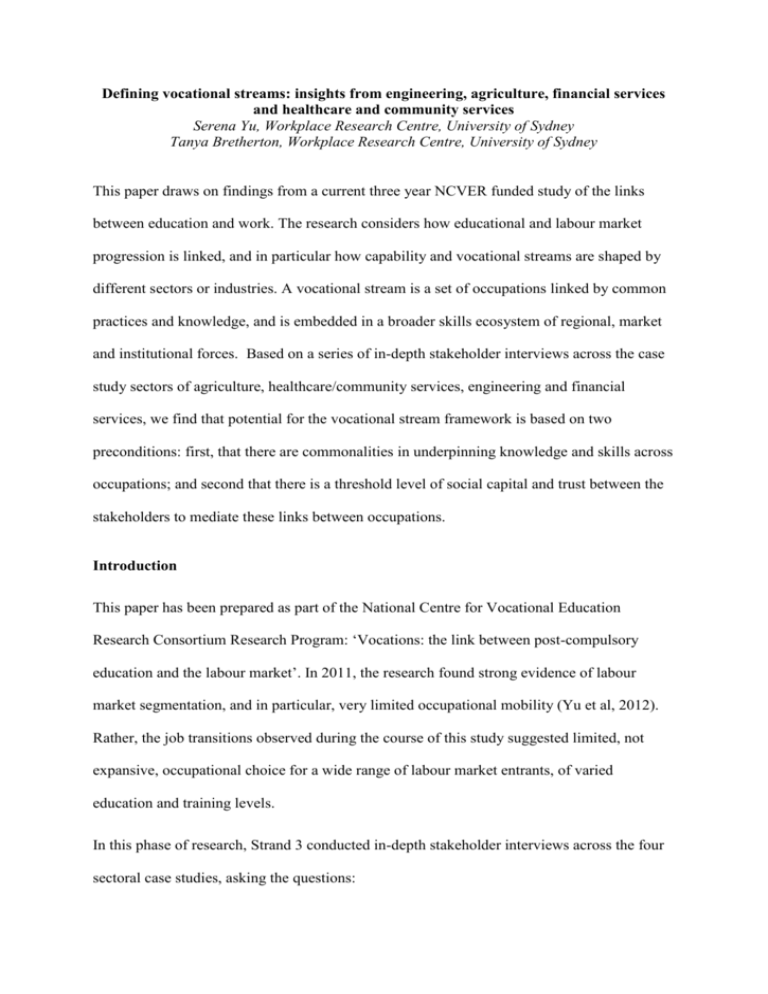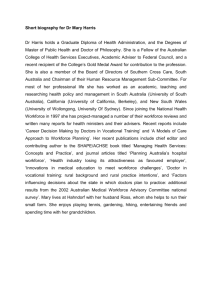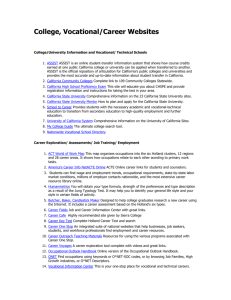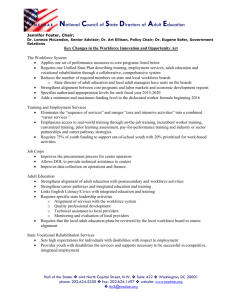Insights from engineering, agriculture, financial
advertisement

Defining vocational streams: insights from engineering, agriculture, financial services and healthcare and community services Serena Yu, Workplace Research Centre, University of Sydney Tanya Bretherton, Workplace Research Centre, University of Sydney This paper draws on findings from a current three year NCVER funded study of the links between education and work. The research considers how educational and labour market progression is linked, and in particular how capability and vocational streams are shaped by different sectors or industries. A vocational stream is a set of occupations linked by common practices and knowledge, and is embedded in a broader skills ecosystem of regional, market and institutional forces. Based on a series of in-depth stakeholder interviews across the case study sectors of agriculture, healthcare/community services, engineering and financial services, we find that potential for the vocational stream framework is based on two preconditions: first, that there are commonalities in underpinning knowledge and skills across occupations; and second that there is a threshold level of social capital and trust between the stakeholders to mediate these links between occupations. Introduction This paper has been prepared as part of the National Centre for Vocational Education Research Consortium Research Program: ‘Vocations: the link between post-compulsory education and the labour market’. In 2011, the research found strong evidence of labour market segmentation, and in particular, very limited occupational mobility (Yu et al, 2012). Rather, the job transitions observed during the course of this study suggested limited, not expansive, occupational choice for a wide range of labour market entrants, of varied education and training levels. In this phase of research, Strand 3 conducted in-depth stakeholder interviews across the four sectoral case studies, asking the questions: How, if at all, are occupations related by underpinning practices and concepts? Can we thus identify occupations comprising a vocational stream? Who are the social partners which oversee these linked (or otherwise) occupations, and how do they support/inhibit the development of capability within and between these occupations? A vocational stream is a set of occupations linked by common practices and knowledge. In this paper, we argue that vocational streams are readily identified across the four sectors, and discuss the preconditions which define how they emerge across the case study sectors. Method In 2012, the project sought to validate the usefulness of the vocational stream framework, and the research process was built around a series of in-depth stakeholder interviews. This involved extensive desktop research reviewing the many initiatives and opportunities which have arisen of great relevance to our research on vocational streams, as well as the release of a discussion paper detailing the questions and issues at hand. Ultimately, fourteen stakeholder interviews were conducted, taking around 60 minutes each. These research participants are detailed in Table 1 below. Note that for engineering in particular, the nature of cross-relationships was such that other organisations, including the industry skills council EE-Oz, and the Australian National Engineering Taskforce (ANET) are indirectly represented. Table 1. Research participants Agriculture Financial Services Healthcare and Community Services Engineering Agrifood Skills Australia Innovation and Business Skills Australia (IBSA) The Community Services and Health Industry Skills Council (CSHISC) The Association of Professional Engineers, Scientists and Managers Australia (APESMA) National Farmers’ Federation Australian Council of the Deans of Agriculture (ACDA) The Chartered Financial Analyst (CFA) Institute The Financial Services Institute of Australasia (FINSIA) Health Workforce Australia (HWA) The Victorian Department of Health The NSW branch of the Australian Medical Association (AMA) The Victorian branch of the Australian Nursing Federation (ANF) The Communications, Electrical, and Plumbing Union (CEPU) The Faculty of Engineering and Surveying at the University of South Queensland (USQ) Findings and discussion Community Services and Health Health and community services represented a critical case study for this research, because of the immediate and growing significance of this industry to the Australian labour market and economy. Despite strong workforce growth, the sector faces significant workforce crises: the workforce is ageing, and workforce “shortages, surpluses and maldistribution” are widely reported (Brownie et al, 2011a). Research participants in this study highlighted the need for greater nursing capacity, from nursing assistants through to enrolled and registered nurses, as well as rebalancing capacity amongst medical practitioners. In healthcare and community services, the notion of vocational streams has been explored through initiatives on expansion of scope, and the positions of generalist workers (from allied health assistants to general surgeons). In particular, care work and nursing, and the allied health professions were highlighted as readily providing linkages between occupations. The importance of intermediate occupations, such as enrolled nurses and allied health assistants, was made paramount, both from a system sustainability and capacity perspective, as well as for providing pathways between occupations and sectors of tertiary education. However, institutional barriers to realising the potential of these vocational streams are numerous and challenging. Fragmented approaches to learning models, accreditation and regulation are mediated by strong occupational groups, as well as TAFEs and universities which are bound by different accreditation structures. These groups may be adversarial, but voice critical issues of maintaining educational as well as job standards, and as yet, there are few examples of forums which engage the various groups in a meaningful and open manner. Traditionally, discussions and deliberations around vocational pathways, and enhancements to capability and competency have traditionally occurred in a deeply segmented way. Yet despite the prevalence of highly specialised occupations and longstanding boundaries, occupational linkages were widely identified. Many initiatives identified during research highlighted the opportunity to enrich the skill levels of all members within a team-based practice. This included trials of nursing assistant models in addition to current staffing levels in Victoria (Victorian Department of Health, 2012), the development of generalist allied health assistants, and the use of general surgeons/physicians across disciplines. However, strong concerns exist around diluting the skills mix, for example, by replacing registered nurses with nursing assistants, instead of recognising the roles of both within a broader team. Concern was also expressed by the AMA and the Faculty of Medicine at Sydney University about the use of other health professionals to replace a doctor’s ability to provide a total diagnosis and assessment. Key informants suggested that the scope for role substitution or expansion is likely more workable in a public hospital setting (where team based practice is already more commonplace) There are key issues here, of affordability versus deskilling, and of expanding capacity versus degrading the role and job standards of one or more occupations. Management of such concerns require careful (and early) consultation within the professional, industrial and regulatory domains, and represents the core challenge. The dominance of occupational groups, and the allied issue of upholding or breaking down occupational boundaries, was a recurrent theme throughout the research. For example, medical colleges may resist reforms in the training requirements of medical graduates and interns, as well as changes in incentive structures; nurses may resist the integration of nursing assistants, and similarly, doctor may show reluctance to accept nurse practitioners within what is traditionally doctors’ scope of practice (eg prescribing medication). Given widely acknowledged work intensification, long hours and heavy case loads, the resistance is not to greater workforce capacity, but to a lack of clarity around roles, and the threat of existing roles being degraded or substituted. Despite the focus on entrenched institutional divides, we have documented numerous pilot and demonstration projects tackling the issues mentioned above. In NSW, an example of a successful, collaborative clinical health network arose in 2001 when the Greater Metropolitan Transition Taskforce was established (NSW Health, 2004). Across fifteen clinical programs, working groups were convened consisting of doctors, nurses and allied health professionals, service managers as well as consumer representatives, with a great focus on communication and inclusiveness. While the health outcomes, in terms of quality of care and equity of outcomes, are undoubtedly the key strength of the network, the Taskforce itself “regards the initiation of a culture change towards greater clinical governance as its most significant achievement... clinicians, managers and consumers have demonstrated a remarkable enthusiasm to join forces across historical divides, analysed the current provision of services for the particular patient group, identified gaps and current and future pressure points” (NSW Health, 2004, p.8). Engineering Engineering skills, across the trades, technical and professional occupations, currently dominate DEEWR’s national skills shortage list (DEEWR, 2012b). This has particularly affected civil and electrical engineers, and the electro-technology, telecommunications and automotive trades. Demand for these engineering skills has been driven by the growth in the resources sector, defence, infrastructure projects including the National Broadband Network, and clean energy/sustainability initiatives (Commonwealth Government, 2012a). The shortages in engineering skills have arisen in part as a consequence of publicly-owned utilities being restructured and sold off, and engineering work being outsourced, from the 1980s and 1990s. The responsibility for the training of engineers and technicians has now fallen to the private sector, who, constrained by serious skills shortages and the pressures of competitive tendering, struggle or neglect to invest in training and workforce development. In engineering, there appears to be limited scope to frame the development of engineering capability around a vocational stream – strong occupational markets prevail around traditional siloes in both the trades and professional engineering, supported by specialised education and training. These demarcations suggest that greater utilisation of the existing workforce will coalesce around strategies within rather than across specialisation; ANET suggests that these strategies will include better tertiary pathways and work-integrated learning, and improving the retention of qualified engineers. There is however, a strong sense of institutional cooperation and willingness to endorse new solutions to a longstanding problem, including strong support for pathways and careers for intermediate/ paraprofessional occupations. There are initiatives within and across the VET-higher education divide, as well by employer organisations, endeavouring to build the engineering skills so desperately needed. Research participants indicated that in both the engineering trades and professions, there is limited horizontal mobility between occupations. Rather, individuals are more likely to specialise vertically within their discipline, or traditionally defined area of practice (such as mechanical trades, or civil engineering), and/or move into managerial positions. While there are some commonalities in the knowledge and skills acquired (e.g. basic fabrication and welding in the trades; computing and design in engineering), specialisation tends to occur quite early within the training and education programs. Where occupational mobility is limited however, deployment of engineering skills across industries is common. Trades workers, technicians and professional engineers work across the mining, construction, manufacturing, transport and utilities industries. Strong occupational labour markets, characterised by the well-recognised value of qualifications overseen by occupational associations such as EE-Oz and Engineers Australia, support strong cross-industry mobility. The importance of intermediate, or para-professional, occupations — typically engineering associates or technical officers with Diploma, Advanced Diploma or Associate Degrees – has been highlighted as a key strategy to alleviating skills shortages and supporting mobility. Consult Australia (2010) suggests many engineering firms are struggling to find civil, structural, electrical and mechanical drafters. As David Dowling of the University of Southern Queensland articulates: “I talk in terms of the champagne glass: we’ve got far more engineers, so that’s the top of the glass, and then this really narrow stem of technologists, and then a little base on it which is the associates. And I think the way the workforce should be redefined, and I’m not sure how this happens, is so that it becomes more a pyramid; so instead of the engineers working in those [standard] spaces, they would have more technicians and so on doing that work”. Watson and McIntyre (2011) give a number of reasons for barriers to a flourishing paraprofessional engineering workforce: Lack of foundational knowledge in maths and physics in the VET training package framework to support either working in technical occupations or higher levels of study. A large number of private RTOs and a weak regulatory framework with respect to the quality of providers leads to inconsistency in the standards of equivalent VET. Flexibility in the training package framework of VET also leads to strong variability in the units studied within any particular VET qualification and necessitates case-by-case consideration of credit granted to students seeking articulation from VET to higher education. Difficulty in achieving the dual purpose of work-readiness as well as a bridge to further study due to differences in VET and higher education (see Dowling, 2010). There are however a number of case studies where the sectoral divide between VET and higher education are being managed successfully, where admission of students on the basis of VET awards is higher, and retention and completion rates for these students are higher (Watson and McIntyre, 2011). These case studies include Charles Sturt University, University of Western Sydney, RMIT University, Swinburne University, and the Australian Maritime College. Their success has been attributed to negotiated curriculum models requiring high levels of institutional trust and commitment, including resource allocation. Professional engineering has also mobilised stakeholders from educational, industry, employee and government groups in the form of ANET, and has sensitised parliamentarians to their cause via the latest Senate enquiry (Commonwealth Government, 2012a). The recommendations arising from recent reports (ANET, 2012; Commonwealth government, 2012) suggest genuine cooperation by considering best practice examples set forth by employers, universities and TAFEs, as well as broad endorsement of solutions which challenge traditional approaches to knowledge and skill formation. Financial Services The financial services sector represents an important contrasting case study for the purposes of this research. While the engineering, agriculture, and health and community services vocational streams might be characterised by a widespread recognition that a skills shortage is imminent, the finance services industry is characterised by contraction, as well as low stakeholder engagement and collaboration on the issue of human capability frameworks. The sector continues to restructure in response to pressures from global uncertainty on its business models, and there is relatively low recruitment activity (Commonwealth Government, 2012b). Of the four sectors in our study, the financial services sector appeared to organically support the notion of vocational streams, especially at an organisational level. Flexible business models, where innovation and contraction routinely change skills demands, as well as fluid occupational labour markets, underpin linkages between occupations. Linkages between occupations are facilitated by strong internal labour markets, including on-the-job training, and a workforce development model which builds disciplinary (and organisational) capabilities on top of cognitive skills recruited at entry. Career progression is characterised as fluid, both between and within firms. The vocational stream could be defined across a range of occupations (both within and between firms)– including compliance clerk, business analyst, risk analyst, financial dealer – within a broad industry practice such as funds management, general insurance, or banking. Respondents regarded such transitions as common, and typically supported by some core disciplinary studies, and/or strong on-the-job learning. The workforce overall is highly qualified, with over 40 percent of workers holding at least a bachelor’s degree, reflecting an occupational distribution where almost one in two workers are managers or professionals (ABS, 2012). Consultations by IBSA indicated that employers see a convergence in ICT and business skills, shifting demand away from specialist, and towards generalist, skills (IBSA, 2012). Importantly, these generalist1 skills support dynamic workforce capability, capability which starts at recruitment at the organisation level; there is a strong focus at initial hiring on crossdisciplinary, advanced cognitive skills (e.g. analytical skills, problem solving and communication). As a result, respondents supported generalist education and training programs, where core capabilities developed are not only employability skills, but vocational units such as knowledge of financial assets, risk and governance, and accounting, which support a range of career directions. Despite the obvious potential for framing capabilities within a vocational stream, this appears to prevail most clearly at the organisational level. Unlike agriculture, engineering or healthcare, there is little semblance of a coordinated strategy (or at least strategic intentions) on workforce development at a systemic level. Unlike the three other sectors, there are no imminent skills shortages, or demographic headwinds, and it is regulatory change which was cited as the most pressing workforce challenge. However, where there is no explicit collaboration, there appears to exist a coherent and tacit respect for vocational capability. That is, key informants readily acknowledged that a broad set of skills, knowledge and experience supports careers across occupational, employer and sub-industry boundaries, and these capabilities receive tacit respect from institutional actors including employers, regulators and educational stakeholders. In saying that there has been no formal mobilisation of institutions around workforce capability is not to say the industry 1 The reference to generalist skills here is distinct from ‘generic’ cognitive skills. Generalist here is vocational in nature, referring to a set of capabilities supporting a field of practice, and sits between generic cognitive/behavioural skills and specific occupational competencies. isn’t highly organised, or mobilised – it is, around the promotion of industry interests (for example, the Association of Superannuation Funds, the Australian Bankers Association), or occupational interests (for example, the Association of Financial Advisors, the National Institute of Accountants). However, there has been no catalyst around workforce development, given that the industry has been able to attract cross-disciplinary skills into the sector, and there appears to be a tacit model of workforce development. We regard the potential level of (explicit) institutional collaboration around workforce development as quite high, given the common and open understandings of vocational capabilities, but this will not necessarily reflect the forms of collaboration seen in agriculture, engineering and healthcare. Agriculture The primary industries sector is an important case study for this research because of the profound and broad sweeping changes facing the sector. In particular, Agricultural production has benefited from major technological advances, in areas as diverse as genetics, robotics, sensors and the use of chemicals. Research participants noted that traditional modes of accumulating skill purely through learning on-the-job increasingly needed augmentation with formal education to acquire more technical skills associated with operating computerised and highly mechanised systems. Indeed, the NFF cites six of the top seven indemand occupations as those being at trade-level or higher (NFF, 2008). At the same time, low levels of VET and higher education enrolments and graduates sustain skill shortages in many intermediate and high skill areas (NFF, 2008). University graduates in agriculture have declined by 40 percent in the last 10 years (Pratley, 2012). Vocational streams in agriculture are underpinned by a high degree of transferability of skills and knowledge across the sector. The main dimension along which an individual can deepen their capabilities within the agricultural vocational stream is most likely be regional. There are well recognised commonalities in cross-occupational and even cross-industry knowledge and skills, with linkages facilitated by fluid labour market pathways. Strong levels of stakeholder trust and collaboration exist in recognition of the severity of the crisis and the fragmented nature of the industry, although there lacks a strong employee voice. Research participants readily identified a vocational body of knowledge and skills supporting many related occupations. This included animal science and husbandry, plant and crop science, production systems ( for example, irrigation and use fertilisers), operation of machinery and technology, sustainable practices ( for example, water, land and carbon management), and agribusiness (for example, financing, marketing and economics). These responses applied to learning within both VET and higher education study, and many of these elements are included in a full course of study. Agribusiness in particular was cited as a strong candidate for facilitating links between VET and higher education. Research participants thus all suggested high levels of transferability of skills exist, both horizontally — for example from on-farm production to professional services (especially for university graduates), across sub-industries as a technician, and vertically into management roles, as well as across industries within a region. The underlying capability was often identified in terms of the knowledge and skills mentioned above. Perhaps more importantly, a significant level of stakeholder and regional co-operation has taken place and continues to gather momentum. Recognising the regional interdependency of both the agricultural and mining industries, in 2011, the Regional Agricultural and Mining Integrated Training (RAMIT) project, a joint initiative between the MCA, NFF, and mining and agriculture industry skills councils, piloted a cross-sector, entry-level training and workforce development model in two rural locations (Morawa, WA, and Emerald, Queensland). The model is being promoted nationally across other regional communities, with key features of its success including the engagement of industry and community representatives, and local champions of the model, with local knowledge and credibility (Skills DMC, 2012). This follows the success of the ‘Make it Work’ project, a partnership between Agrifood and Narrabri Shire Council in north-western NSW. The project created a sustainable, local labour force by coordinating seasonal labour needs across industries including agriculture, mining, manufacturing, infrastructure management and retail, and providing cross-industry training, resulting in a Certificate III in Rural Operations. The model is being rolled out nationally in four locations between 2012 and 2014, supported by over $4 million in funding. The comments below from Agrifood Australia explain the importance of such positive momentum across the sector: “We’re a very fragmented industry and to have a whole range of people trying to gain the upper hand as it were is actually not doing anyone any good and I think they’ve realised that a collaborative approach is where it’s going and working together, so I think that’s happened... politicians have become sensitised too, and so we now have bi partisan interest and sensitivity to this issue” Vocational streams: Potential and consequence For the purposes of this paper, a distinction is drawn between vocational stream potential and vocational stream consequence, as a way to qualitatively describe how a range of factors can influence the emergence of the vocational streams which ultimately emerge. We first consider the preconditions most likely to underpin a successful vocational stream model of workforce development – vocational stream potential, before considering how (current) realisations of these conditions can characterise outcome scenarios – vocational stream consequence. A vocational stream is defined as set of occupations linked by common disciplinary knowledge, skills and capabilities, within a broader field of practice. The importance of establishing links between occupational groups was recognised, to varying degrees, in all case study sectors. These commonalities took on a number of dimensions across the four sectors. In healthcare, health workers share common capabilities both horizontally across traditional occupational boundaries, as well as vertically, into higher levels of responsibility, in areas including nursing and allied health. In financial services, mobility within a broad area of practice took on an organisational dimension. This was characterised by strong recruitment processes, horizontal and vertical career paths, and training within strong internal labour markets. The most dominant theme in the agricultural industries was one of regional capabilities. This has already emerged strongly in areas where commonalities in local skills and knowledge extend across agricultural, local government and mining operations in Emerald, Queensland. In engineering, highly structured education and training paths within both the trades and professions tend to emphasise specialisation relatively early, so there is a greater focus on linking para-professional/technical occupations to the professional engineer. Commonalities in capabilities is one of two enabling conditions for realising greater, and more adaptive, workforce capacity around a vocational stream framework. The second is that of social partner readiness, or the potential for institutional commitment and cooperation on workforce challenges. This involves mobilising and consolidating a community of trust around a common objective – dire skills shortages – and involves not only compromise and pursuit of cooperative solutions, but also a commitment of resources. Social partner readiness recognises two key tenets of social capital theory: first that durable forms of social capital must exist (including trustworthiness, networks and institutions), and second that the linkage between social capital and collective action is trust (Ostrom and Ahn, 2003). In each of the four sectors, we observed varying levels of social capital, ranging from tacit networks in financial services, to a complex web of formal and informal institutions in healthcare. The importance of trust too was highlighted across the case studies, ranging from high levels of contestation in healthcare to forums for debate and consensus among employer, union, and educational groups in engineering and agriculture. These two preconditions – commonalities in capabilities and social partner readiness – provide the genesis of four models of ‘vocational consequence’, which characterises potential outcomes depending on how the preconditions are met: Segmentation is characterised by a lack of commonalities in underpinning knowledge and skill, as in the engineering sector, where specialisation tends to occur early, and there is limited mobility across occupational boundaries. Segmentation is therefore likely to persist despite a cooperative set of social partners. Cross-roads is defined by a hitherto absence of institutional cooperation, despite recognised commonalities in capabilities between occupations. Two scenarios exist within this model: first, in the healthcare/community services sector, institutional arrangements are characterised by groups which defend entrenched institutional boundaries; second, in financial services, there is an absence of explicit stakeholder engagement around skills issues, with workforce development flourishing implicitly across the sector. Consolidation is characterised by both recognised commonalities in capabilities linking occupations in a scope of practice, as well as a higher level of social partner readiness as witnessed by greater levels of stakeholder engagement and a commitment or resources, as in agriculture. Fragmentation is characterised by both weak linkages between occupational capabilities, and weak (or absent) social partners. While none of our case studies exemplified this category, this consequence has been specified for the sake of completeness, and for exploration in future research. Visually, we can present the four sectors against their current preconditions of commonalities in capabilities and social partner readiness, and show the scope for possible future movements, Figure 1. The four quadrants represent the outcome scenarios of fragmentation, segmentation, cross-roads, or consolidation. Figure 2 Preconditions for vocational stream potential Conclusions All sectors stand to gain, in terms of both workforce utilisation and capacity, as well as improved pathways for students and workers, by fostering both dimensions of vocational potential. We argue that the identification and promotion of both commonalities in capabilities and greater institutional cooperation has the capacity to assist with current severe workforce challenges and also to support a workforce of more adaptable, capable, individuals. In each sector, we identified strong examples of initiatives taken to work towards collaborative solutions, models or ideas which reach across educational, industry and government divides to give individuals access to educational and occupational pathways. In the third and final phase of research in 2013, we will endeavour to consolidate the architecture of these models, and explore how their successes could (or could not) be deployed in different settings. Acknowledgements This work has been produced by NCVER under the National Vocational Education and Training Research (NVETR) Program, which is coordinated and managed by NCVER on behalf of the Australian Government and state and territory governments. Funding is provided through the Department of Industry, Innovation, Science, Research and Tertiary Education. The NVETR Program is based on priorities approved by ministers with responsibility for vocational education and training. This research aims to improve policy and practice in the VET sector. For further information about the program go to the NCVER website <http://www.ncver.edu.au>. The author/project team was funded to undertake this research via a grant under the NVETR Program. These grants are awarded to organisations through a competitive process, in which NCVER does not participate. References Agrifood Skills Australia (2012), 2012 Environmental scan of the agrifood industry. Kingston, Australian Capital Territory. Australian Bureau of Statistics (2012), Census of Population and Housing. Canberra, Australia. Australian National Engineering Taskforce (2012), Realising an innovation economy, viewed October 22 2012, < http://www.anet.org.au/wp-content/uploads/2012/04/ANET_Realising_Innov_econ.pdf>. Brownie, S., Bahnisch, M. & Thomas, J. (2011), Competency-based education and competency-based career frameworks: Informing Australian health workforce development. University of Queensland Node of the Australian Health Workforce Institute in partnership with Health Workforce Australia, Adelaide, Australia, viewed September 4 2012, <http://www.hwa.gov.au/sites/uploads/national-competency-report-final20120410.pdf >. Commonwealth of Australia (2012a) The shortage of engineering and related employment skills. Senate standing committee on education, employment and workplace relations, < viewed October 25 2012, http://www.aph.gov.au/Parliamentary_Business/Committees/Senate_Committees?url=eet_ctte/engineering/report /report.pdf >. ——(2012b), Financial and insurance services: Employment outlook. Canberra, Australia, viewed November 2, 2012, < http://www.deewr.gov.au/lmip/PortalFile.axd?FieldID=5907846 >. Consult Australia (2010), The Future of the VET system. Submission to Skills Australia on the future of the VET system. Department of Education, Employment and Workplace Relations (2012), Skills Shortage List Australia 2011-2012, Canberra, Australia, viewed October 25, 2012, <http://www.deewr.gov.au/Employment/LMI/SkillShortages/Documents/AUSSkillShortagelistJune2012Final.pd f >. Dowling, D. (2010), The career aspirations and other characteristics of Australian paraprofessional engineering students, viewed October 25 2012, < http://eprints.usq.edu.au/18170/1/Dowling_AaeE2010_1_PV.pdf >. Health Workforce Australia (2012), Workforce innovation program: Caring for older people, viewed August 24 2012, https://www.hwa.gov.au/sites/uploads/caring-for-older-people-final-report-201205.pdf >. Innovation and Business Skills Australia (2012), Environment scan – 2012: Financial services industry, viewed October 25, 2012, < http://www.ibsa.org.au/Portals/ibsa.org.au/docs/Research%20&%20Discussion%20Papers/Escan/EScan2012/IB SA%20Escan%202012%20-%20Financial%20Services.pdf >. National Farmers Federation (2008), 2008 Labour shortage action plan, March 2008, viewed September 4, 2012 < http://www.nff.org.au/get/3022.pdf >. New South Wales Health (2004), Embracing change: Report of the Greater Metropolitan Transition Taskforce. NSW Department of Health, North Sydney. Ostrom, E. & Ahn, T.K. (2003), Foundations of social capital. U.K. Edward Elgar Publishing Limited, Cheltenham. Pratley, J. (2012), Professional agriculture: A case of supply and demand. Australian Council of Deans of Agriculture. Skills DMC (2012), Regional agricultural and mining integrated training (RAMIT): Final report, Sydney, New South Wales, viewed October 15, 2012 < http://www.skillsdmc.com.au/Library/PageContentVersionAttachment/b0d566a0-4dc1-4829-b690947b9decc8a3/ramit_report_may_2012b.pdf >. Training.gov.au (2011a), Qualification details: CHC40108 Certificate IV in Aged Care, viewed August 24 2012, < http://training.gov.au/Training/Details/CHC40108 >. ——(2011b), Qualification details: HLT42507 Certificate IV in Allied Health Assistance, viewed August 24 2012, < http://training.gov.au/Training/Details/HLT42507 >. Victorian Department of Health (2012), Workforce innovation grant program 2010-2011, viewed August 24 2012, <http://docs.health.vic.gov.au/docs/doc/8E5C6DAD64A58686CA25796D000F4F65/$FILE/WIGP%20Projects% 20Information%20Sheet.pdf >. Watson, L. & McIntyre, J. (2011), Scaling Up: Building engineering workforce capacity through education and training. Australian National Engineering Taskforce (ANET), viewed October 25, 2012, < http://www.anet.org.au/wp-content/uploads/2011/06/ANET-Scaling-Up2.pdf >.








